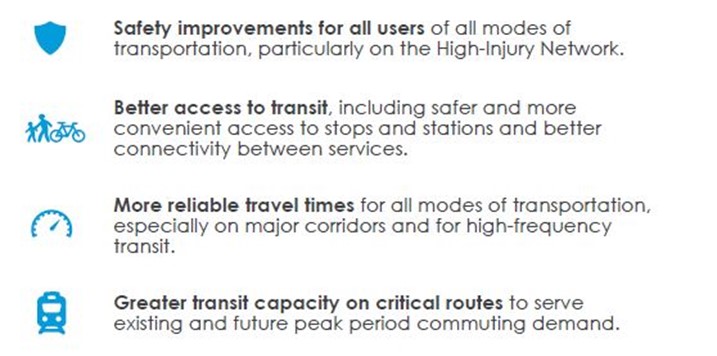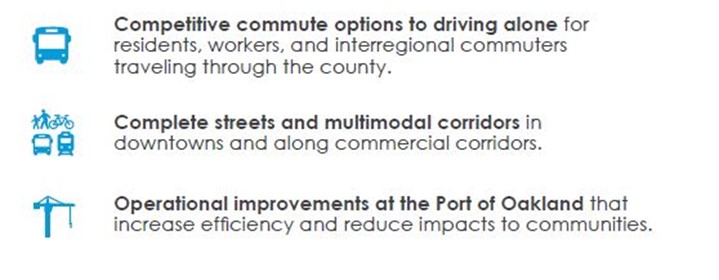- A countywide transportation needs assessment
- Infrastructure project and program recommendations
- Identifying gaps, opportunities, strategies, and near-term actions
The Countywide Transportation Plan envisions the future of transportation in Alameda County
Approximately every four years, Alameda CTC updates the Countywide Transportation Plan (CTP) to respond to changing conditions and evaluate new opportunities and demands placed on the transportation system. The CTP creates a vision for the future of transportation in Alameda County, sets priorities, and guides decision-making at Alameda CTC as it plans, funds, and delivers transportation improvements.Next Steps for the CTP
In the coming months, the CTP team will work on the following tasks before releasing a draft of the plan in 2026:- Summer – Fall 2025: Staff will gather public feedback on transportation priorities through community events and the survey, working closely with community-based organizations on our CTP Working Group to incorporate feedback into the plan.
- Summer – Fall 2025: Staff will review project and program ideas submitted by local jurisdictions and partner government agencies.
- Winter 2026: Staff will share updates with the Commission on needs, gaps and opportunities, as well as an update on the draft plan recommendations.
- Spring 2026: A draft Plan will be available for a round for public engagement before finalizing.

The Policy Blueprint is the foundation of the 2026 CTP
The CTP Policy Blueprint grounds this plan update in policy, and represents first milestone in plan development. The Blueprint will inform all aspects of CTP development and set the four plan goals: safety, equity, climate, and economic vitality.CTP Vision and Goals
“Alameda County residents, businesses, and visitors will be served by a premier transportation system that supports a vibrant and livable Alameda County through a connected and integrated multimodal transportation system promoting safety, equity, sustainability, access, transit operations, public health, and economic opportunities.”
The four goals for the 2026 CTP together advance the transportation vision:- Safety: Reduce fatalities and severe injuries of all users towards zero by deterring unsafe speeds, prioritizing vulnerable users, and implementing the Safe System Approach.
- Equity: Advance deliberate policies, systems, and actions to deliver a transportation system that removes barriers and transportation-related inequities and results in more equitable opportunities, access, and positive outcomes for marginalized communities.
- Climate: Create safe multimodal facilities to walk, bike and access public transportation to promote healthy outcomes and support strategies that reduce reliance on single-occupant vehicles and minimize impacts of pollutants and greenhouse gas emissions.
- Economic Vitality: Support a resilient Alameda County economy and vibrant local communities through a transportation system that is affordable, clean, reliable, well-maintained, and integrated with land uses that support sustainable travel.
- HIN Update: The HIN is a tool for understanding which corridors have a history of the most fatal and serious injuries based on reported collision data. Alameda CTC developed its first HIN in 2019. The 2024 HIN includes collision data for the years 2018-2022 and will be used in tandem with the 2019 HIN to provide a comprehensive countywide HIN which identifies areas of potential safety concern over time.
- PSN Framework: The PSN identifies roadway locations where vulnerable users, such as students and people walking to access transit, may be most exposed to conditions that have been shown to contribute to fatal and serious injury collisions. This framework will help the CTP identify and prioritize areas for safety improvements in a proactive way, rather than reacting to collision data, which has a number of limitations. The PSN will be developed in phases, with the framework and initial concept network included in the Blueprint and the final network subject to data refinement with jurisdictions through the CTP phase.
The 2026 CTP will build on inclusive engagement to move the Blueprint forward
Alameda CTC’s Countywide Transportation Plan is an exciting opportunity to shape the future of the county’s transportation system for people who walk, bike, roll, drive, and ride transit. Building on a year of community and partner agency engagement, the plan has four goals: safety, equity, climate, and economic vitality.
We completed a major round of public engagement in October 2025. Between July and October, we received over 2,000 survey responses and talked to nearly 4,000 individuals across 21 events throughout the county. That feedback will inform the draft plan, which we plan to release by Spring 2026. To stay updated on the plan and learn about upcoming opportunities to provide input, please sign up here. Please send any questions to CTP@alamedactc.org.
Building strong community partnerships for the CTP
In the first year of the Policy Blueprint, staff connected with over 500 Community-Based Organizations (CBOs) and met with approximately 40 to gather feedback on engagement practices and the CTP’s development. To deepen relationships built in the previous phase and to involve more voices, the Policy Blueprint recommended creating a CTP Working Group to continue advising engagement and shaping the plan.Based on interest and availability, ten organizations have joined the CTP Working Group. CBO representatives are compensated for their time and have met twice so far to review the engagement plan and share ideas. At these meetings, the group provided feedback on how to reach various audiences, helped shape the community survey, and suggested events to attend and/or partner with.
Organizations participating in the CTP Working Group include:
- El Timpano
- Girls Inc. of Alameda County
- Center for Independent Living
- Roots Community Health
- Cherryland Community Association
- San Leandro 2050
- Afghan Coalition
- Deaf Plus Adult Community
- CityServe of the Tri-Valley
- Three Valleys Community Foundation
Alameda CTC Committee and Commission Meeting Materials
Below are key presentations and memoranda prepared as part of the 2026 CTP process. Materials will be updated as plan documents are developed.- 2026 CTP Policy Blueprint Kickoff (November 2023 PPLC)
- CTP: Making Alameda County Safer (February 2024 PPLC)
- CTP: Making Alameda County More Equitable (April 2024 PPLC)
- CTP: Advancing Clean Transportation in Alameda County (June 2024 PPLC)
- CTP Update: Draft Goals and Safety Update (July 2024 PPLC)
- CTP: Approve the Countywide Transportation Plan Policy Blueprint and High-Injury Network and Priority Safety Network Report (October 2024 PPLC)
- 2026 CTP Update (February 2025 ACTAC)
- 2026 CTP Mid-Year Update (July 2025 PPLC)
Previous CTPs
- Final 2020 Countywide Transportation Plan (30 MB)
- Final 2020 CTP Project List
- Final Community-Based Transportation Plan
- Final New Mobility Roadmap
Needs Assessment Report
The Needs Assessment documents countywide and local transportation needs for public transportation, walking, biking, driving, and goods movement. This assessment pulls together findings from a variety of reports and plans completed by the Alameda CTC over the last few years.The following countywide needs serve as the foundation for the priority Project and Strategy recommendations described in the 2020 CTP. The most critical countywide transportation needs are relevant to all communities in Alameda County, including:


Countywide Poll (May 2019)
Alameda CTC conducted a countywide survey on residents’ transportation needs and priorities in May 2019. The poll was representative of the county’s diverse population across planning areas and included a deliberate emphasis on gathering input from residents in low-income communities and communities of color to ensure their voices were heard.
CBTP Outreach (Oct 2019 – Feb 2020)
Alameda CTC held “pop-up” events at high foot traffic locations or community events in low-income communities and communities of color between October 2019 and February 2020. Focus group interviews were conducted with community leaders and community-based organizations by phone in February 2020 to develop a full and nuanced understanding of transportation needs and priorities in low-income communities and communities of color.
Virtual Outreach (Aug – Oct 2020)
Due to COVID-19, the final phase of outreach on the 2020 CTP was done virtually, relying on a survey, a virtual open house via the Alameda CTC website, and virtual focus groups across the county. Promotions were sent out to agency email lists and social media. Local agency partners helped promote the survey and webpage through their social media channels.
Public Meetings (Jan 2019 – Nov 2020)
Public Alameda CTC Commission and Committee meetings discussing the 2020 CTP were held throughout the process, with materials posted ahead of time to the Alameda CTC website. At these meetings, elected officials and members of the public were able to help shape the overall approach, vision and goals, identification of transportation needs, and priorities for projects, programs, and strategies to be included as core recommendations.
Engagement revealed several recurring key issues and needs:
- Improved safety for active transportation
- More connected and affordable public transit
- Equitable outcomes for low-income communities
- Freeway congestion and commute options
- Addressing climate change and air quality
- High-quality roadways
Alameda CTC Committee and Commission Meeting Materials
Below are key presentations and memoranda prepared as part of the Draft 2020 CTP process. Materials were presented to the Alameda CTC Planning, Policy, and Legislation Committee (PPLC); Multimodal Committee (MMC); and Projects and Programs Committee (PPC),- Development of the 2020 CTP Update, January 2019 PPLC
- CTP Draft Approach, July 2019 PPLC
- CTP Vision and Goals, September 2019 Commission
- Shared Mobility/Transportation Network Companies, October 2019 PPLC
- CTP Needs Assessment Part 1, January 2020 PPLC
- CTP Needs Assessment Part 2, March 2020 PPLC
- Community-Based Transportation Plan, May 2020 PPLC
- CTP Draft Multimodal Strategies, June 2020 MMC
- CTP Draft Core Recommendations and COVID-19, July 2020 Commission
- Adoption of the 2020 CTP and companion documents, Community-Based Transportation Plan and New Mobility Roadmap, November 2020 PPLC
- Adoption of the 2020 CTP and companion documents, Community-Based Transportation Plan and New Mobility Roadmap, November 2020 Commission


